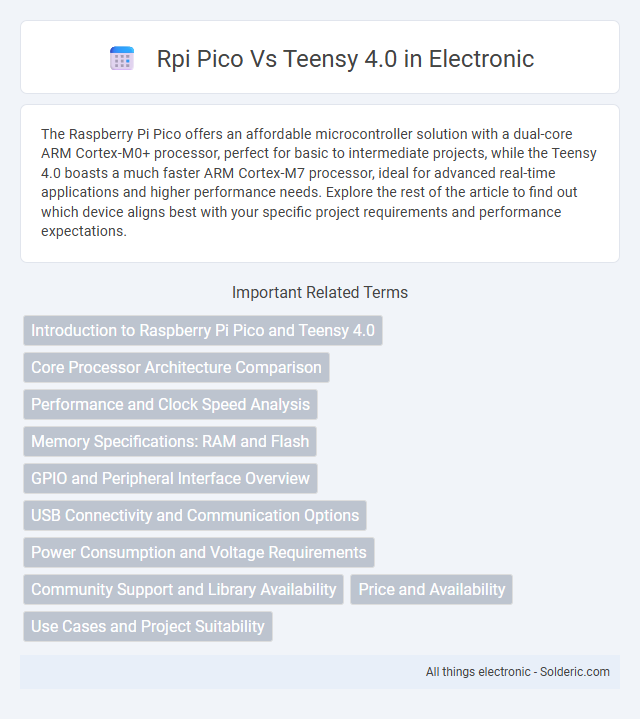The Raspberry Pi Pico offers an affordable microcontroller solution with a dual-core ARM Cortex-M0+ processor, perfect for basic to intermediate projects, while the Teensy 4.0 boasts a much faster ARM Cortex-M7 processor, ideal for advanced real-time applications and higher performance needs. Explore the rest of the article to find out which device aligns best with your specific project requirements and performance expectations.
Comparison Table
| Feature | Raspberry Pi Pico | Teensy 4.0 |
|---|---|---|
| Processor | RP2040 Dual-core ARM Cortex-M0+ @ 133 MHz | NXP i.MX RT1062 ARM Cortex-M7 @ 600 MHz |
| Flash Memory | 2 MB on-board QSPI Flash | Up to 2 MB on-chip Flash |
| RAM | 264 KB SRAM | 1024 KB RAM |
| Digital I/O Pins | 26 GPIO | 40 digital I/O pins |
| Analog Inputs | 3 x 12-bit ADC channels | 14 x 12-bit ADC channels |
| USB | USB 1.1 Device | USB 2.0 Full-Speed/High-Speed Device & Host |
| Operating Voltage | 3.3 V | 3.3 V |
| Price | Approx. $4 | Approx. $20 |
| Use Case | Low-cost, simple embedded projects | High-performance, complex applications |
Introduction to Raspberry Pi Pico and Teensy 4.0
The Raspberry Pi Pico features the RP2040 microcontroller with a dual-core ARM Cortex-M0+ processor running at 133 MHz, designed for low-cost, versatile embedded applications. The Teensy 4.0 offers a powerful ARM Cortex-M7 processor clocked at 600 MHz, providing high performance and extensive I/O options for demanding projects. Both boards support a range of peripherals and development environments, but the Teensy 4.0 excels in processing power and real-time capabilities.
Core Processor Architecture Comparison
The Raspberry Pi Pico features a dual-core ARM Cortex-M0+ processor running at 133 MHz, optimized for low power and efficient microcontroller tasks. In contrast, the Teensy 4.0 boasts a more powerful ARM Cortex-M7 core clocked at 600 MHz, offering significantly higher performance suited for complex real-time processing and advanced applications. This architectural difference positions the Teensy 4.0 as a superior choice for intensive computing, while the RPi Pico excels in energy-efficient control and simpler embedded projects.
Performance and Clock Speed Analysis
The Teensy 4.0 outperforms the Raspberry Pi Pico with a 600 MHz ARM Cortex-M7 processor compared to the Pico's dual-core 133 MHz ARM Cortex-M0+. This significant clock speed difference translates into faster computation, higher throughput, and enhanced real-time performance for demanding applications on the Teensy 4.0. Your choice depends on whether you prioritize raw processing power or low-power efficiency.
Memory Specifications: RAM and Flash
The Raspberry Pi Pico features 264KB of SRAM and 2MB of onboard QSPI flash memory, providing moderate storage and memory for embedded applications. In contrast, the Teensy 4.0 boasts 1024KB of RAM and 2MB of flash memory, delivering significantly higher memory capacity suited for more complex projects. The Teensy 4.0's larger RAM enhances data processing capabilities, while both microcontrollers offer comparable flash storage for program code.
GPIO and Peripheral Interface Overview
The Raspberry Pi Pico offers 26 multifunctional GPIO pins supporting interfaces like I2C, SPI, UART, and PWM, ideal for moderate embedded projects. Teensy 4.0 provides 40 GPIO pins with advanced peripheral support including multiple I2C, SPI, UART buses, CAN, and touch sensing, geared towards high-performance applications. Both microcontrollers feature flexible pin multiplexing, but Teensy 4.0's faster processor and broader peripheral range make it superior for complex interfacing needs.
USB Connectivity and Communication Options
The Raspberry Pi Pico features a native USB 1.1 controller capable of USB device and host modes, supporting USB Mass Storage and HID device functionalities, suitable for basic USB communication tasks. In contrast, the Teensy 4.0 offers a high-speed USB 2.0 full-speed device port with enhanced USB MIDI, audio, and serial capabilities, enabling more complex and faster data transfers. Teensy 4.0's advanced USB stack supports multiple simultaneous USB device types, making it ideal for projects requiring extensive USB interaction and reliable communication.
Power Consumption and Voltage Requirements
The Raspberry Pi Pico operates at a voltage range of 1.8 to 3.3V, with power consumption typically around 100 mA during active use, making it highly efficient for low-power applications. The Teensy 4.0 requires a 3.6 to 5.5V supply and consumes approximately 100 mA under load but can peak higher depending on processing demands, reflecting its higher performance capabilities. Both microcontrollers offer low power modes, but the Pico's RP2040 chip excels in ultra-low power consumption, ideal for battery-operated and energy-sensitive projects.
Community Support and Library Availability
The Raspberry Pi Pico benefits from a vast and active community with extensive forums, tutorials, and official support from Raspberry Pi Foundation, ensuring rich library availability for various applications. Teensy 4.0, while having a smaller but dedicated user base, offers a robust set of libraries through the PJRC website and compatibility with Arduino IDE, catering to advanced users requiring high performance. Your choice should consider the ecosystem maturity and available resources aligned with your project's complexity and learning curve.
Price and Availability
The Raspberry Pi Pico offers a highly affordable price point around $4, making it accessible for hobbyists and educational projects, with widespread availability through major electronics retailers and online platforms. The Teensy 4.0, priced approximately at $20 to $25, brings advanced processing capabilities but is generally less accessible due to limited stock and availability primarily through specialized distributors. Cost efficiency favors the Pico for budget-conscious users, while Teensy 4.0's price reflects its higher performance and niche market presence.
Use Cases and Project Suitability
The Raspberry Pi Pico excels in affordable, low-power projects such as sensor monitoring, simple robotics, and education due to its dual-core ARM Cortex-M0+ processor and extensive GPIO pins. Teensy 4.0, featuring a powerful 600 MHz ARM Cortex-M7 CPU, is better suited for advanced audio processing, real-time control, and complex embedded applications requiring high-speed performance. When choosing your microcontroller, consider the Teensy's superior processing capabilities for demanding tasks and the Pico's cost-effectiveness for straightforward or resource-constrained projects.
rpi pico vs teensy 4.0 Infographic

 solderic.com
solderic.com